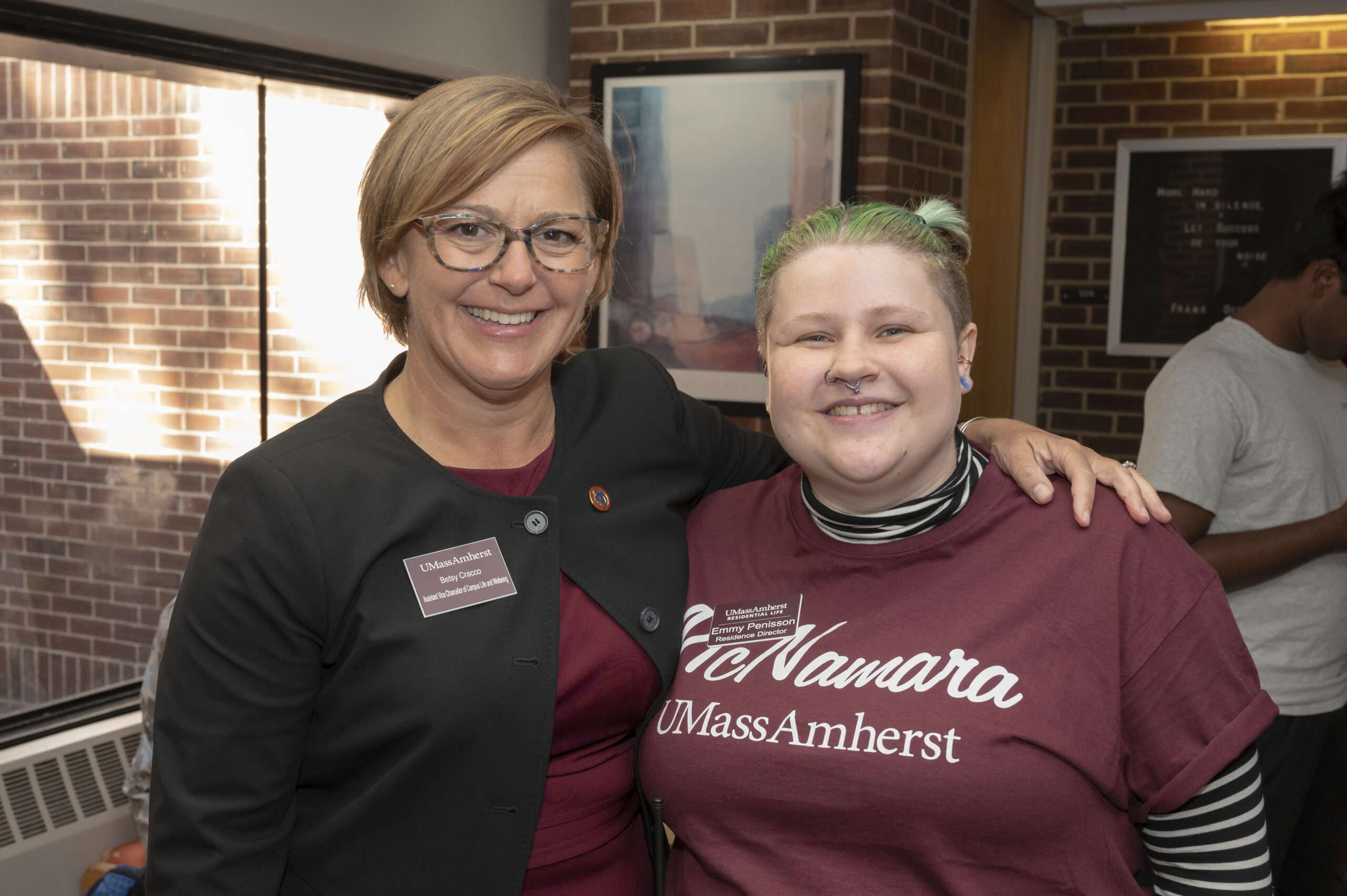Elizabeth “Betsy” Cracco does not take herself too seriously, avoids jargon, and explains public health and community wellbeing strategies with analogies involving frogs and ponds and building houses.
Cracco’s plain-speaking approach may serve her well as she continues her role as assistant vice chancellor for Campus Life and Wellbeing, a newly-created position at the University of Massachusetts, Amherst, aimed at one of the biggest challenges facing higher education today — improving wellbeing among a generation of students reporting high rates of anxiety, depression, and loneliness. Cracco’s office oversees Recreation and Wellbeing, Residential Life, and the Center for Counseling and Psychological Health, a three-legged stool supporting students’ psychological and physical health. She said the nexus of all of these domains underpins her mission.
“One of the biggest prescription pads we have is making connections and creating a sense of belonging–and you can’t do that from a seat in the counseling center alone,” she said.
Cracco said cabinet-level wellness positions like hers are becoming more common on college campuses, due to the increased concern over student mental health and the growing acknowledgment that what has been called the campus mental health crisis is more of a public health problem, meaning multiple departments need to get involved to address it. In many ways, Cracco’s professional trajectory aligns with this expanded view.
After graduating from College of the Holy Cross in Worcester, Massachusetts, Cracco received a master’s degree in counseling from Boston College, then a doctorate in counseling psychology from the University of Wisconsin Madison. Holy Cross, a Jesuit school, had a strong sense of community and it was there that she took an interest in mind-body practices and attending retreats. Her first job was in residential life, living in a dorm, where she quickly learned that the position functioned as a way for students to share their personal stories, from eating disorders to relationship issues. Her professional training included the relational culture model out of Wellesley College, a feminist ideology that puts the emphasis on the individual in context within the community. This led her to apply a public health approach to her work.
“It occurs to you after you go from client to client in direct care that something else is wrong,” she said. “There is a systemic problem here we need to think about. In other words, if all of the frogs in the pond are sick, why are we still asking, ‘What’s wrong with this frog?’”
Cracco said her metaphorical move up-stream started early. When she was head of counseling at the University of Connecticut, she began a retreat program called C2 for “Connect and Challenge,” involving whitewater rafting, storytelling, and meditation. When the new position of (then called) executive director of wellness opened at UMass Amherst, the state flagship campus, Cracco went for it. In her pitch presentation, her first slide included Maya Angelou’s advice on what we need to ask each other when we move into any social setting: “Do you see me? Do I know that you care about me? Is it important I am here?”
“If all of the frogs in the pond are sick, why are we still asking, ‘What’s wrong with this frog?’”
“If we could enact this same approach at a community level, it would mean that no matter what your struggles are, you would be held and you would not be alone because your community mates would be there, many going through the same struggles,” said Cracco.
When she got the job in 2019, Cracco asked herself, “Am I hired to create a cohesion across three units on a campus, or am I hired to promote wellbeing across the entire campus?” She figured, either way, it was about crossing silos and making connections, something that became surprisingly possible during the pandemic and would lead to UMass signing on to the Okanagan Charter: An International Charter for Health Promoting Universities and Colleges.
“During the pandemic, we really demonstrated how we could work together as a campus and how the academic side of the house can provide real, on-the-ground services. The public health students, the nursing students, they ran the clinics, gave the vaccinations, all of it. After that, our dean of public health, dean of nursing, and vice chancellor of student affairs got together and said, ‘How can we keep this going?’ We figured the starting point was signing on to the Okanagan Charter.”
Having the buy-in from then Chancellor, Kumble Subbaswamy, a prerequisite in signing the charter, meant that everyone on campus had some responsibility to promote wellbeing, including faculty. Cracco said the tie-in to student success helped make the case.
“You are not going to do well academically if you never sleep, eat trash, and have no social life, and we need to communicate that to students,” she said. “We all need to get out of the boxes we’ve made.”
As an example of out-of-the-box thinking, Cracco’s team introduced a curriculum developed by the Benson-Henry Institute for Mind Body Medicine at Mass General Hospital, called Positivity and Relaxation. The nine-session, credit-bearing course is taught in small groups and helps students self-regulate around anxiety in particular, but also depression. It is not an alternative to therapy for those who need it, but an option for all students on campus. Cracco said they are running 300 to 400 students a year through these small group sessions and they’re receiving data on its effectiveness from the school of public health.
“You are not going to do well academically if you never sleep, eat trash, and have no social life, and we need to communicate that to students.”
“We are seeing tremendous reductions in stress, increases in wellbeing, even increases in sense of belonging,” said Cracco.
The course is funded by her office, but not owned and operated by any one department. As she tinkers with its scale, Cracco is working with professionals within and beyond campus on developing other courses, some involving storytelling, and working closely with a colleague on courses specific to building resilience and belonging in students of color. As big a fan as she is of retreats, she said representation is an important consideration to watch in mind-body practices. “Who is teaching these practices?” she asks. “How do students feel when they are in them? There’s definitely a privileged, “Lululemon” subculture that exists here and we need to be aware of that.”
As far as other programs go, whether it’s pond fire chats or another unnamed project involving swings she is secretly plotting, Cracco is full force as long as it is about making connections and forming relationships. One of her latest efforts is to create quiet dining spaces for groups to eat “family style.”
“We should be structuring connections at every turn,” she said. Asked about how this work plays out in the classroom, Cracco made an interesting point about technologies like ChatGPT.
“We are no longer in a system where we have a person who has all the knowledge and people who receive that knowledge, because knowledge is everywhere,” she said. “Now, the process of learning is the process of learning together, like we do in the real world, and that is going to force a structure that is more communal, more experiential.”
Cracco is optimistic about the wellness work taking place at UMass: “I think people are getting the upstream thing,” she said. At the same time, the down-to-earth Cracco is realistic about how much can be done, given what she calls “the tyranny of time.” As an example, she leans into her first higher ed job in residential life and compares that to the myriad of duties and trainings that those professionals now need to complete.
“What these people really want to be doing is making space for students,” she said. “We need professional staff to attend to those crisis situations, and these can be incredibly time consuming. How do we develop the human capital to make space for connection beyond, before and apart from the crises?”




